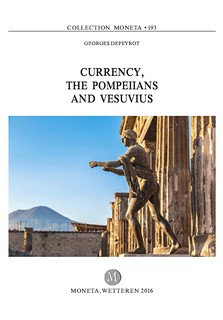
PREV ARTICLE
NEXT ARTICLE
FULL ISSUE
PREV FULL ISSUE
NEW BOOK: CURRENCY, THE POMPEIIANS AND VESUVIUSGeorges Depeyrot writes: Lastest volume: Moneta # 193, G. Depeyrot, Currency, the Pompeiians and Vesuvius, Wetteren, 2016, 204 p., ISBN 978-94-91384-61-5 see http://www.moneta.be Moneta published in the Collection Moneta studies devoted to numismatics and monetary economy (all periods, all regions, and all languages).
Here's the book's description from the Moneta web site. -Editor
Pompeii is a unique case. The sudden eruption of Vesuvius on October 24th, 79, stopped life in the city. At this moment (1 pm), a large part of the population was working outside the town. While the inhabitants of Herculaneum had enough time to try to escape from the city, Pompeii was quickly covered with pumice that made it impossible to return to the city or obstructed escape from the houses that the first pyroclastic flows very rapidly submerged. Pompeii is a unique opportunity to see a frozen image of coin circulation, even if the immediate looting of the ruins may have disturbed the remains. During the extensive excavations conducted in the 18th and 19th centuries a huge number of coins were found, but unfortunately they were largely mixed together or lost. However, the diaries of the excavations give many imperfect mentions of coin finds. Nevertheless a collection of all these imprecise descriptions offers a picture of the coins and the city. The main purpose of this study is to understand the reality of currency distribution. It is time to try to analyse how many coins were found and how many coins were in the hands of the population. What was the reality of the coin supply in such an Italian town? How many coins had each Pompeiian, by metal, and by regio. What was the composition of their savings? When did they segregate coins according to metal? What was the relationship between the monetary stock and prices? What was the role and the level of intervention of the bankers in comparison with the precious hoards and savings of the rich Pompeiians? Can we deduce from the coin finds the social position of the inhabitants of the various villae? MONETA 193, 204 pages 75 euros contents ISBN 978-94-91384-61-5 For more information, or to order Moneta #193, see:
Georges adds: Moneta (www.moneta.be) is now completely changing its system of communication. If you want to receive a mail informing you of new publications, of new promotions or discounts, leave your email address on http://www.moneta.be. Now there is a -20 % / -25 % discount on all the volumes see details also on the page http://www.moneta.be Wayne Homren, Editor The Numismatic Bibliomania Society is a non-profit organization promoting numismatic literature. See our web site at coinbooks.org. To submit items for publication in The E-Sylum, write to the Editor at this address: whomren@gmail.com To subscribe go to: https://my.binhost.com/lists/listinfo/esylum All Rights Reserved. NBS Home Page Contact the NBS webmaster 
|
